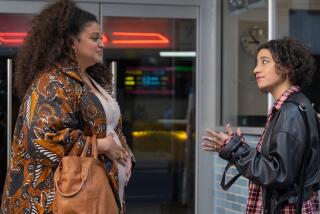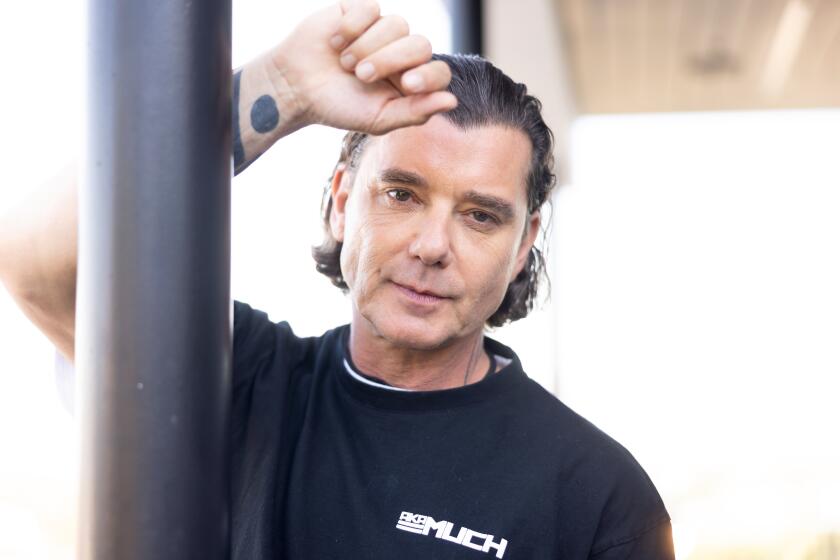For Hollywood, news biz is turning into showbiz
- Share via
Two stories that flashed across my journalistic radar screen on the same day recently seemed at first glance so obviously and mutually contradictory that I found myself doing one of those head-shaking double takes.
The first was yet another account of ever-growing public cynicism and hostility toward the news media. Nothing surprising there. Even before the last few years’ Hall of Shame plagiarism and fabrication performances by Jayson Blair of the New York Times, Jack Kelley of USA Today and Stephen Glass of the New Republic, the media’s reputation had been sinking faster than Hillary Clinton at a Rush Limbaugh pool party.
But the second story, which -- like the first -- originated in the Boston Globe, reported that Hollywood is increasingly turning to the news business “in search of laughs, drama or just a story to tell.”
Hollywood has already converted the repugnant Glass saga to celluloid -- last year’s “Shattered Glass” -- and now there are several other pending or potential movie and television projects that revolve around the news media: “Anchorman,” a romantic comedy about a television newsman with “raging hormones, perfect hair and an inflated ego.” “Country of My Skull,” an interracial drama about reporters covering the Truth and Reconciliation Hearings in South Africa. A half-hour HBO comedy about a cable news network. A prime-time network sitcom about a television sports reporter. Another about a singer-turned-reporter on a newsmagazine show that will remind some of a bad episode of “20/20.” A third based on the experiences of a Time magazine reporter. A fourth about a newspaper columnist.
Isn’t it incongruous to expect audiences to watch movies and television shows about people and a profession they claim to increasingly dislike and mistrust? What’s going on here? Lights, camera, retraction?
No, says Robert Thompson, director of the Center for Popular Television at Syracuse University.The decline in public respect for the media may make journalists better subjects than ever for Hollywood.
“Instead of showing the news media as heroic people fighting the good fight, this gives the entertainment media the opportunity to expose their underbellies,” he says. “Journalists are now beating out lawyers as the most despised profession out there, but as that happens, their potential to be the subject of great narratives and
A convenient character
Journalism as a vehicle/subject for entertainment is not a new phenomenon, of course. Movies have focused on the newspaper world at least as far back as a 1909 silent short, “The Cub Reporter,” a comedy about a reporter covering a story in a mental institution when he’s captured by the inmates. (Today, of course, the reporter probably would be an inmate.)
Hollywood has subsequently offered audiences such media-centric fare as “The Front Page,” “Citizen Kane,” “His Girl Friday,” “Network,” “Broadcast News” and “The Insider,” to name just a few.
Often, a journalist is the main character in a movie, but the movie is “packaged in another genre and isn’t really about journalism,” says Richard Ness, author of “From Headline Hunter to Superman: A Journalism Filmography.”
“The Ring,” released in 2002, was a horror film in which the lead character just happened to be a journalist, much as the lead character in television’s “Everybody Loves Raymond” just happens to be a journalist.
One pilot in development at CBS takes a similar approach to the life of Washington Post columnist Tony Kornheiser.
“His profession and the workplace are almost secondary,” says Wendi Trilling, senior vice president for comedy series development at the network. “The show has more to do with his take on fatherhood, marriage and family life.”
But even when the public “isn’t much interested in the practice of journalism, it’s intrigued by the character of the journalist,” Ness says.
“The reporter always seems to be on the front line of things happening right now, and audiences find that appealing.”
The journalist also is “a convenient character,” Ness says, “a type the audience easily recognizes, sort of like the cowboy. Screenwriters don’t have to spend a lot of time explaining who he is.”
This is especially true today, when journalists -- through their books, speeches, television appearances and, yes, their scandals -- have become increasingly visible public figures.
The very scandals that have blackened the media’s reputation may have simultaneously whetted the public’s appetite for more.
“Watching C-SPAN and press conferences and the 24-hour news cycle and seeing all these ‘inside baseball’ stories and scandals on cable and in media columns gives people a feeling for the rhythms of the profession,” says Siva Vaidhyanathan, director of communications at New York University.
“That sense of familiarity may combine with the love/hate relationship people have with the media to create an emotional tension between the audience and the on-screen journalistic characters.”
Journalism as comedy
Familiarity is, of course, essential to the success of any television series, and episodic television also has taken a periodic look at the media world, in part because it, like other TV series staples -- police departments, hospitals, schools, law offices -- fits a clear, inexpensive, audience-pleasing formula: A small cast of characters, working on essentially the same set every week, gets involved in a series of engaging human interest stories in which the viewer can vicariously participate.
“Lou Grant,” which featured Ed Asner as a crusty city editor during its five-year run on CBS in the late 1970s and early ‘80s, was television’s best entertainment program focused on the news media. But like its 1970s big-screen counterpart, “All the President’s Men,” “Lou Grant” was both serious and largely complimentary to the practitioners of journalism.
“It would be hard to do a show like that in the current climate,” Thompson says. “The idea of journalists as ... noble knights tilting at the windmills of corruption and social inequality just wouldn’t fly today.”
That may be one reason the emphasis now is on journalism as comedy.
ABC has three sitcoms in development that involve media figures, and all three grew out of the network’s desire to put specific performers in inherently humorous situations.
“We didn’t set out to ... develop a bunch of shows about the media,” says Stephanie Leifer, ABC’s senior vice president for comedy programming, “but in sitcoms, you’re looking for ways to put different types of people together in one place and have them say something funny ... and the media is a great place [to do that].
“So we do wind up spoofing the on-air people ... poking fun at the media.”
Maybe that’s inevitable these days. Still, I don’t think it bodes well for the media or -- in the long run -- for society that network executives think people want to laugh at journalists (especially if the network executives are right).
Many of us in the media probably do take ourselves too seriously. We deserve to be made fun of from time to time. But I’d hate for us to become stock sitcom characters.
Just think, though: If “Cheers,” another of those ensemble-cast-in-a-familiar-setting sitcoms, had been set in a reporters’ bar, of which there is at least one in every big city, it could have been called “Jeers.”
David Shaw can be reached at [email protected]. To read his previous “Media Matters” columns, please go to latimes.com/shaw-media.
More to Read
The biggest entertainment stories
Get our big stories about Hollywood, film, television, music, arts, culture and more right in your inbox as soon as they publish.
You may occasionally receive promotional content from the Los Angeles Times.










